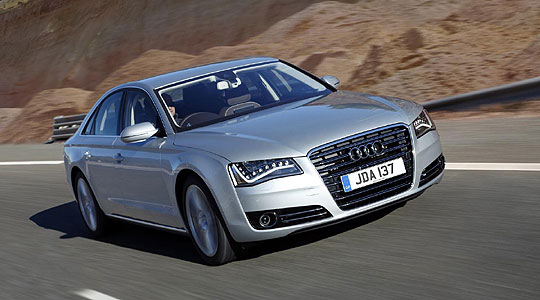
To the super-rich, the new A8 will be seen as a bargain. It gives the style of motoring they require without attracting the attention and resentment of those less fortunate.
The A8 is anything but downmarket, anything but dull, and yet it blends in comfortably with the rest of the traffic. “There goes another Audi,” people will think, not realising that the A8 4.2 TDI Quattro SE Exec that has just swept past them is loaded with luxury options that push the price up to £95,050.
You don’t have to spend that much to get one; that just happens to be the price of the first car we tested, available now – along with the 4.2 FSI model – for deliveries starting in June. Very soon, the 3.0 TDI will also arrive in Britain and is likely to be the most popular model at first, with a recommended on-the-road price starting at £54,835. Other variations to follow include a long wheelbase, a supercharged 3-litre petrol version and an economy model with front-wheel drive instead of the quattro 4WD system.
New technology has made the A8 safer, faster and more competent than ever but the biggest improvements are in fuel consumption – 19 per cent better mpg in the case of the TDI – and greatly reduced CO2 emissions.
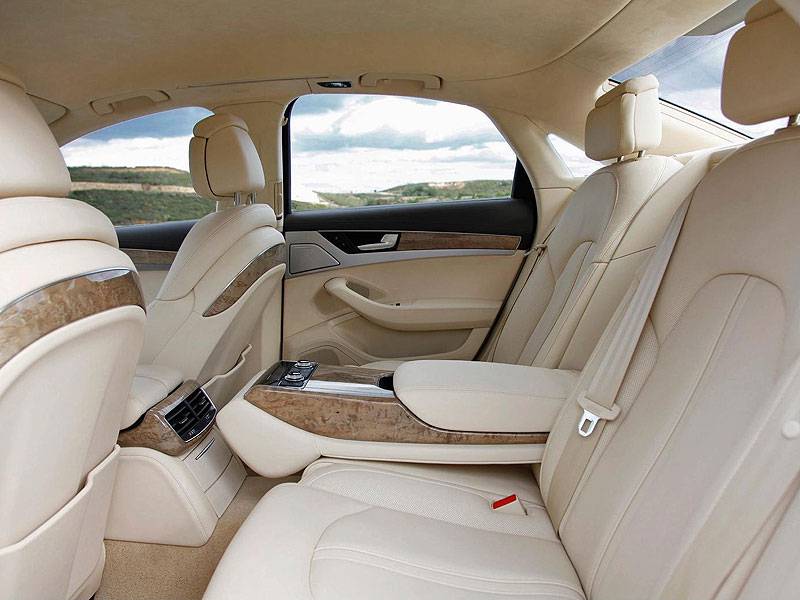
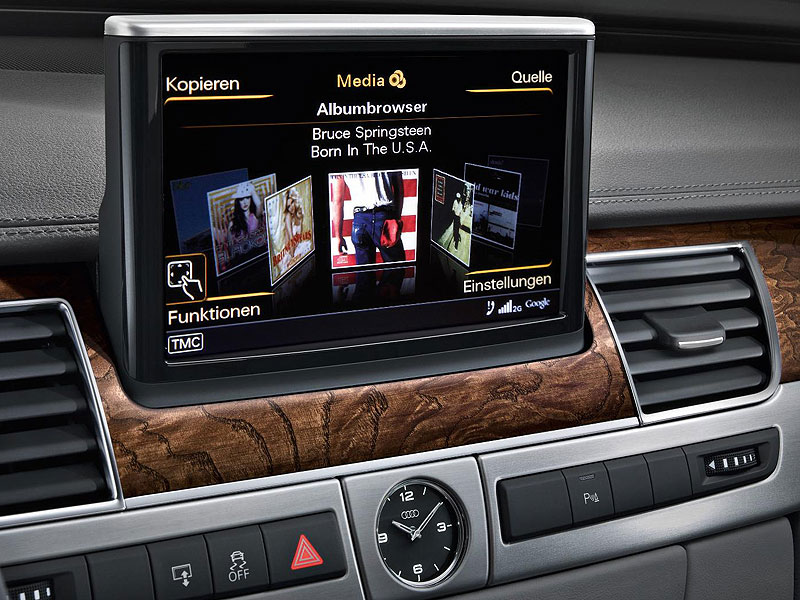
For openers, we were given the chance to drive two upmarket models, the 4.2 TDI and the equally attractive 4.2 FSI, powered by a normally aspirated V8 petrol engine. Also fitted with numerous options, ‘our’ 4.2 FSI test car’s price would be £89,700.
The relative desirability of these two top-of-the-range A8s would once have been an easy matter to assess but times have changed. The diesel wins on fuel consumption, predictably enough, but even so you’d still expect the sporting purist to go for the petrol engine every time. Well, the sporting purist will have to think again, simple as that. He might still retain his loyalty to petrol engines but, if so, it won’t be for the traditional reasons. The latest diesel engines are nothing like the noisy, unresponsive sloggers of the past. Yes, diesel-powered Audis have won at Le Mans and that has altered the image of compression ignition engines favourably in the minds of some, to a degree, but the full truth of what has been achieved probably hasn’t sunk in.
This isn’t just about ‘image’; the throttle response of this latest TDI engine is something we wouldn’t have believed possible 10 years ago. This engine is a genuine high-performance item and it’s in no way less appealing to the ‘sporting’ motorist than any petrol engine. It is quiet, extraordinarily smooth and it gets up and goes – stonkingly fast – at the first hint of an opening throttle.
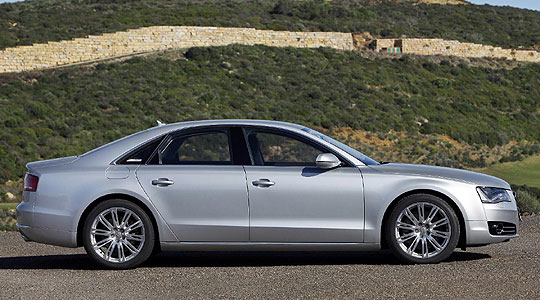
Both of these engines are 90-degree V8s, the FSI displacing 4163cc and the TDI 4134cc. Maximum power for the FSI is 372PS at 6800rpm, with torque of 328lb ft at 3500rpm. Figures for the TDI are 350PS at 4000rpm and a mighty 590lb ft at 1750-2750rpm. Both are governed to a top speed of 155mph and the 0-62mph figures are similar – 5.7 seconds for the FSI and 5.5 seconds for the TDI. Combined fuel consumption is 29.7mpg for the petrol engine, 37.2mpg for the diesel, and both have a 90-litre fuel tank giving an excellent range for both models.
Just two minor points could keep those sporting types in the petrol camp. One might be an understandable, lingering, nostalgic pleasure derived from the sound of a petrol engine, which is still there if commendably remote in these luxurious Audis. More significant might be the difference in weight up front in the car, which is one of those finer points to be appreciated by connoisseurs of chassis behaviour.
The 4.2 FSI model is 160kg lighter than the 4.2 TDI, a difference of eight per cent and there is a subtle difference to be felt in slow corners. However, the steering effort seemed to be the same in both models and this distinction is so fine that very few people would be likely to notice it. Both models handle exceptionally well, as befits a sophisticated premium sector saloon car with a highly developed all-wheel drive system.
The latest A8s all have a new eight-speed Tiptronic gearbox, this transmission system being better-suited to these relatively large, powerful engines than the DSG gearboxes that work so well in smaller cars. With eight forward ratios, top gear is exceptionally long and this gearbox alone is claimed to have reduced fuel consumption by about six per cent. Gear changes are extremely smooth and the transmission can be used for luxury cruising or maximum performance with equal ease.
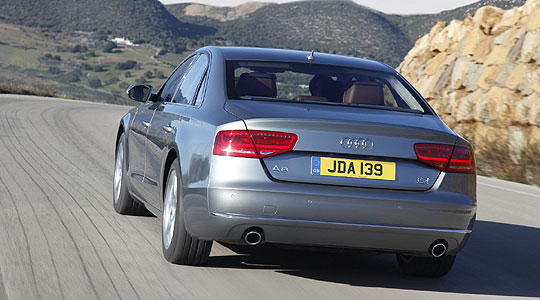
Remarkably, the gearshift strategy and cruise control are both linked to the satellite navigation system – so that the correct gear will be selected for any corners ahead. This technology, which can save fuel by making the right decisions, obviously depends on the quality of the information received from the satellite. That varies from area to area and it’s difficult to tell how well it works. All I can say is that, left to its own devices in automatic mode, these A8s always seemed to select the most appropriate gear.
According to the blurb, the optional adaptive light cornering system is also linked to the navigation unit but, as I was unable to drive these cars at night, it wasn’t possible to see how well this intriguing new gadget works on entering a corner in the dark.
At the heart of the A8, the all-aluminium structure of the lightweight, high-quality bodyshell remains a distinguishing feature. In its latest form, it is very slightly lighter than before but the torsional stiffness has been increased impressively by 24 per cent.
Two specification levels are available in UK models – SE and SE Executive. All A8s are lavishly equipped with such things as leather seats, double glazing, cruise control, traction control, ESP, satellite navigation and much more. The standard SE Executive specification adds such diverse items as Audi’s advanced parking system, 19in wheels and electrical boot opening and closing.
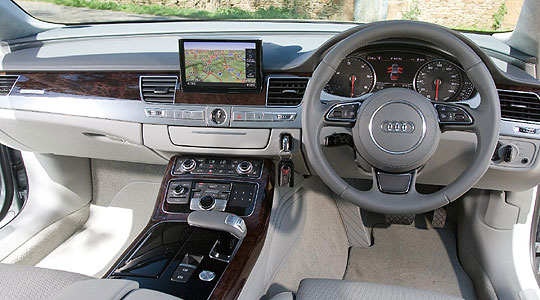
The costly extras in our test cars included such luxuries as seat ventilation and massage function, as well as valuable safety aids, including night vision assistant with pedestrian detection and the Audi Assist package with pre-sense plus. There are four pre-sense options available, reducing the risk of collisions and then optimising passenger safety when an accident is inevitable. If the full pre-sensor system is fitted, for example, the A8 can detect an impending collision from the rear. When that happens, it closes the windows and sunroof, tensions the belts and moves the front seats into the optimum position for passenger protection.
Typical owners will almost certainly possess several cars but the elegantly understated, immensely capable A8 is likely to be the one they choose to drive every day.
Text: Tony Dron
Photos: Audi
ClassicInside - The Classic Driver Newsletter
Free Subscription!






